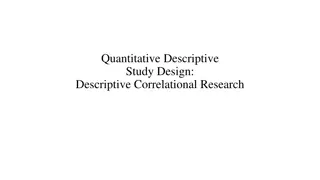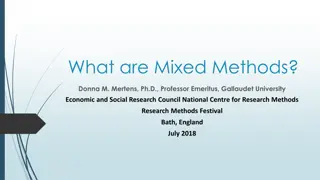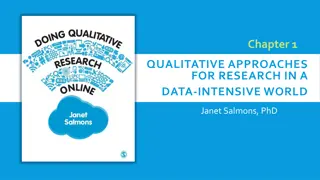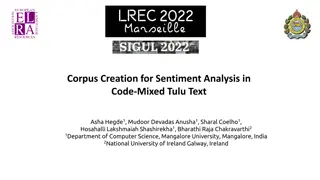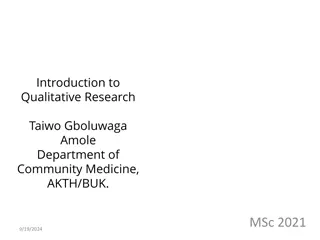Understanding Research Methods: Quantitative, Qualitative, and Mixed Approaches
This introduction provides an overview of qualitative, quantitative, and mixed methods research, highlighting key differences and various types of research approaches. It delves into exploratory, descriptive, and causal research methodologies, offering insights into problem discovery, data collection and analysis, ethics, and more. A quick exercise at the end presents scenarios for identifying whether research is exploratory, causal, or descriptive.
Download Presentation

Please find below an Image/Link to download the presentation.
The content on the website is provided AS IS for your information and personal use only. It may not be sold, licensed, or shared on other websites without obtaining consent from the author. Download presentation by click this link. If you encounter any issues during the download, it is possible that the publisher has removed the file from their server.
E N D
Presentation Transcript
An Introduction to Quantitative, Qualitative and Mixed Methods Research
RESEARCH METHODS Overview Introduction to Research Methods What is Qualitative Research? What is Quantitative Research? Key differences between both approaches Mixed Methods
An Introduction Research Methods
RESEARCH METHODS A useful reminder . Problem Discovery Research Question Research Method Ethics Data Data Collection Processing & Analysis Conclusion Sampling Dissemination
RESEARCH METHODS Types of Research Exploratory Descriptive Causal
RESEARCH METHODS Exploratory Research Explores and tries to understand the issue in order to define it and suggest hypotheses For example, qualitative methodologies attempt to unearth a theory from the data
RESEARCH METHODS DescriptiveResearch Describes a phenomenon or a population Aim is to highlight an issue or to increase knowledge about its nature Usually reliant on statistics (quantitative data)
RESEARCH METHODS Causal Research Attempts to establish the relationship between different aspects (variables) of an issue Tests hypotheses (ideas or theories about what s happening) to establish whether there is a relationship Helpful in trying to establish the effectiveness of an intervention
Quick Exercise Exploratory, Causal or Descriptive? 1. Posttraumatic stress disorder in the context of terrorism and other civil conflict in Northern Ireland: Randomized controlled trial. Duffy, Michael (2008) In: British Medical Journal, 334, 147-150. 2. The Belfast Youth Development Study (BYDS): a prospective cohort study of the initiation, persistence and desistance of substance use from adolescence to adulthood in Northern Ireland. Higgins, Kathryn; McLaughlin, Aisling; Perra, Oliver; McCartan, Claire; McCann, Mark; Percy, Andrew; Jordan, Julie-Ann. In: PLoS ONE, Vol. 13, No. 5, 23.05.2018.
Short Video https://study.com/academy/lesson/an- overview-of-qualitative-research.html
Qualitative Research Involves immersion in the situations of everyday life Researcher s role is to gain an overview of the whole of the culture/situation under study The researcher seeks to capture data from the inside, rather than having preconceived notions of what will be found Qualitative research is interpretive (making sense of what s happening) Most analysis is done in words
Interviews a structure, a method of capturing the responses and a process for analysing the responses Generally referred to as a conversation with a purpose Interested in gaining an individuals interpretation of an issue Differs from a conversation in that there is a research purpose,
Focus Groups Interviews with a group of individuals (6-8 is the optimum size) Can be more or less structured in the format of the questioning Facilitation of the group discussion by the researcher is key Importance of group dynamics both positive and negative that effect the process Observation of the process is as important as the spoken contribution
Ethnography Involves the researcher, either openly or covertly, participating in the lives of those being studied for an extended period of time Various data collection techniques can be used observation, asking questions, joining in activities Difference between: - insider: participating in the setting - outsider: focusing on the setting
Documentary Analysis Various types of documents produced in social life professional records, newspaper stories, diaries. Often intended as objective statements of fact but are socially constructed There is the surface meaning (of what is said) and the underlying meaning (of what is intended)
How to appraise Qualitative Research
Key Questions Is there a clear research question being posed: How do female victims of domestic violence make sense of the response of the police to their situation? Is a qualitative methodology appropriate? Is the particular qualitative method (eg interviewing, documentary analysis, observation) fit for purpose?
Cont. Has the researcher used an appropriate method and sample? Do the findings link to the data? Are the inferences and conclusions drawn by the researcher logical? Have the categories of findings been appropriately constructed? What is the degree of researcher bias and is it clear what checks have been put in place to deal with these? What strategies have been employed to increase the credibility of the findings?
Questions about the sample There is a need to ensure that the subjects being studied are appropriate to the research question: Would you interview female victims of domestic violence or police officers? How many individuals/groups/situations need to be studied to make the findings generalisable? How are the participants in the research recruited and might this bias the findings: Do you interview victims who have never contacted the police? Or only those were the police have prosecuted the perpetrator?
Short video https://study.com/academy/lesson/what-is- quantitative-data.html
Quantitative Research According to Aliaga and Gunderson (2000) quantitative research attempts to explain things by collecting numerical data that are analysed using mathematically based methods (in particular statistics) . The important distinction is that quantitative data needs to be numerical (otherwise it can t be analysed)
Cont As such there are some questions that are particularly suited to collecting numerical data -How many people in the population have a diagnoses of diabetes? -What is the average mark of students enrolled on post-graduate courses at QUB or Ulster?
There are also types of data that arent naturally numerical but we can transform them e.g. E.g. questionnaires that ask people to rate their mood on a number of statements (e.g. strongly agree , agree , disagree or strongly disagree ). Each statement may be assigned a number from 1 -4)
Advantages of quantitative approaches Sometimes we need to answer population level questions (e.g. how many of those in care have experienced trauma?) Sometimes we need to test a hypothesis (e.g. if X engaged in Y their outcomes would improve by Z% Sometimes we need to know the link between to things (e.g. diet and disease)
Types of Quantitative Research?
Survey using questionnaire Relatively cheap to administer; if completed with a researcher can confirm or clarify questions May restrict number of respondents; can exclude some of the population e.g. those without phones, those who can t communicate verbally etc.
Existing Databases Secondary data-relatively cheap; study can review existing large data sets; coding has already taken place; can tell you something previously not known Coding may have already taken place; you are not responsible for issues around data collection (risk of design flaws)
Experiments An experiment is where the researcher intervenes to change something (e.g., gives some patients a drug) and then observes what happens. Example -Plying a person with beer to see whether empathy increases or decreases when drunk;
Quantitative data influences everyday life and death decisions Knowing your quant data that help you make decisions and stop being mislead .. https://twitter.com/i/status/1290497186489348096
Task Spend a few minutes trying to develop a quantitative research question Tips Think about the type of question (relationship or difference between two variables, establish causation etc.) Think about whether the data is numerical or if it can be converted into numbers What data collection tool would you use?
Key Questions Is a quantitative methodology appropriate? Is the particular quantitative method (eg experiment, survey, interviewing, database) fit for purpose?
Cont. Has the researcher used an appropriate method and sample? Do the findings link to the data? Are the inferences and conclusions drawn by the researcher logical? Have the findings been appropriately analysed? What is the degree of researcher bias and is it clear what checks have been put in place to deal with these? What strategies have been employed to increase the credibility of the findings?
Key differences between both approaches
Quantitative Research Attempts to explain things by collecting and analysing data (Corby, 2006) It tells you if there is a difference or a relationship but not necessarily why (Miller et al, 2003) Data collected are always numerical and analysed using statistical methods (Bryman, 2012) Some types of research questions lend themselves better to quantitative approaches than others (Silverman, 2010) Quantitative research focuses on the explanation of data Interested in generalisability
Qualitative Research Qualitative research aims to provide a deeper understanding of an issue (Brown, 2010) Understand the meaning from the perspective of those engaged in the study (Miller et al, 2003) Increase awareness of our social world (Jones, 1995) Qualitative research focuses on exploration of data Interested in depth not generalisability
QUANTITATIVE QUESTIONS QUALITATIVE QUESTIONS What proportion of the NI population earns below 12000? Has academic achievement declined in the last 10 years for looked after children? What is the effectiveness of counselling for depression? What are the experiences of those living in minimum income households What are the perceptions of looked after children who attend mainstream education The evolving relationship between therapists and their clients during counselling treatment
What is Mixed Methods Research?
Mixed Methods Research that combines quantitative and qualitative methods within a single project (Bryman, 2016) Mixed methods research requires a purposeful mixing of methods in data collection, analysis and interpretation (Shorten and Smith, 2017) Offers a framework for combining methods (Timans et al., 2019) Allows researchers to explore different perspectives and relationships that exist between the intricate layers of multifaceted research questions (Shorten and Smith, 2017) Sometimes researchers use both, and in different ways, but for it to be mixed methods they has to be an interaction between the two approaches
Appraising Mixed Methods Research
Appraising the quality of mixed methods research has been the subject of much debate (Barnat et al., 2017; Halcomb, 2018; O Cathain, 2010) A consensus on quality measures is yet to be reached however some key questions include: Is the mixed methods design relevant to address the qualitative and quantitative research question? Is the integration of qualitative and quantitative data relevant to address the research question? Is appropriate consideration given to the limitations associated with this integration?
Next session will be on Designing Research The research process Designing a research project Co-designing research Assignment task Assignment guidance Designing a review project guidance and example Critical review guidance and example
Brian Taylor, Campbell Killick and Anne McGlade (2015) Understanding and using research in social work. London: Sage Learning Matters.









